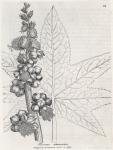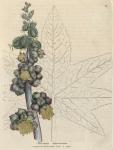
 Synonyma. Ricinus. Pharm. Lond. & Edinb. Gerard. Emac. p. 496.
Synonyma. Ricinus. Pharm. Lond. & Edinb. Gerard. Emac. p. 496.
Ricinus vulgaris. Bauh. Pin. 432. J. Bauh. Hist. iii. p. 642.
Ricinus sive Cataputia major vulgatior. Park. Theat. p. 182. Raii Hist. p. 166.
Ricinus 1. Fruticosus assurgens foliis majoribus peltato-lobatis, lobis serratis acutis. Browne's Jam.
p. 350.
Ricinus Americanus fructu racemoso hispido, &c. Sloane's Cat. 38.
The Oil nut tree. Long's Jam. v. iii. p. 712.
Ricinus foliis peltatis inaequaliter serratis, capsulis hispidis. Miller, Figures of Plants, tab. 219.
In horto botanico Gottingensi tres exstant varietates:
α glauca, caule petiolis costisque foliorum stipulis pedunculis capsulisque pallide rubris. Ricinus ruber Rumph. Herb. Amb. tom. iv. p. 79.;
β nitens, caule petiolis costis foliorum ceterisque partibus et summis foliis sanguineis. Ricinus lucidus Jacquin. Misc. Austr. vol. ii. p. 360. et Icon. rarior. tab. 27. ut puto;
γ glauca totaque viridis praeter stylos rubicundos. Ricinus albus Rumph. l. c. p. 92. Avanacoe s. Citavanacu. Hort. Malab. tom. 2. p. 57. tab. 32. Vide Murr. App. Med. v. iv. p. 195.
Class Monoecia. Ord. Monadelphia. Lin. Gen. Plant. 1085.
Ess. Gen. Ch. Masc. Cal. 5-partitus. Cor. o. Stam. numerosa. Fem. Cal. 3-partitus. Cor. o. Styli 3, bifidi. Caps. 3 locul. Sem. 1.
Spec. Char. R. foliis peltatis subpalmatis serratis.
The root is biennial, long, thick, whitish, and beset with many small fibres: the stem is round, thick, jointed, channelled, glaucous, of a purplish red colour towards the top, and rises luxuriantly six or eight feet in height: [Long says, that in Jamaica it grows with surprising rapidity to the height of fifteen or sixteen feet. l. c.] the leaves are large, and deeply divided into seven lobes or pointed serrated segments, of a bluish green colour: the footstalks are long, tapering, purplish, and inserted in the disc of the leaf (peltated): the flowers are male and female on the same plant, and produced in a clustered terminal spike: the male flowers are without a corolla, and consist of a calyx, divided into five oval pointed purplish segments, enclosing numerous long stamina, which unite at the base: the female flowers occupy the upper part of the spike, and have the calyx cut into three narrow segments, of a reddish colour: the styles are three, slender, and forked at the apex: the capsule is a large three-celled nut, covered with tough spines, and contains three flattish oblong seeds, [Hujus cuilibet loculo inest nux ovata, utrinque compressa, interiori praecipue superficie, quae et linea longitudinali distinguitur, magnitudine seminis Phaseoli minoris flore phoeniceo, hilo prominente sursum notato, cui callus ante adhaeserat. Cortex ex bruno luteoque variegatus, fragilis, cingit nucleum album, vestitum cuticula tenella concolore—Figurae seminis cum infecto Ricino (Acaro Ricino L.) bobus & canibus infesto, similitudo ansam denominationis totius plantae dedit. Murr. Ap. Med. vol. iv. p. 197.] which are forced out on the bursting of the capsule. It is a native of both the Indies, and flowers in July and August.
This plant appears to be the (greek) or (greek) of Dioscorides, [Mat. Med. lib. 4. cap. 164.] who observes that the seeds are powerfully cathartic; [Their violent and irritating effects in this way are noticed by almost all the Materia Medica writers, and seem to be confirmed by Thunberg, (Diss de Medicina Africanorum, p. 4. and Browne, (l. c). This acrimony however appears from later experiments to be owing to the membranes which invest the kernel, (vide Heyer in Crells n. chem. Entdeck. P. 2. p. 47. Also Glendenberg in ejusd. chem. Annal. 1785. vol. ii. p. 34). Bergius says, "Semen unicum Ricini vulgaris, tempore vespertino, a viro sano & vegeto masticatum & deglutitum, sapore suit amygdalarum, sed sensationem mordentem in faucibus reliquit. Per totam nostem tranquille dormivit hic vir; sed sequente die mane expergefactus, emesi violentia correptus suit atque per totam diem sustinuit nisus alternates vomituritionis & purgationis alvi, tametsi parum dejiciebat. Eadem vice nobilis matrona tenerae constitutionis, semen unicum pariter comedit, sed prius testam membranamque obvelantem sedulo separavit abjectique; & nullam noxam inde sensit." M. M. p. 774.] it is also mentioned by Aetius, Paulus Aegineta, and Pliny. The Ricinus was first cultivated in England in the time of Turner, [Vide Hort. Kew.] (1562) and is now annually reared in many gardens in the neighbourhood of London; and in that of Dr. Saunders, [From the number of seeds which the Doctor has lately procured from different parts of the globe, and his scientific and solicitous care in their cultivation, we are induced to hope, that Medical Botany, under such auspices, will eventually receive considerable illustration.] at Highbury, the plant from which the present figure was taken, it grew to a state of great perfection. An oil extracted from the seeds [Where the oil is rejected, the seeds may be carefully separated from their shells and the inner white membrane, and formed into an emulsion, and given as an agreeable substitute for the oil.] of this plant, and known by the name of oleum ricini, Palma Chrifti, or caftor oil, is the drug to which the pharmacopoeias refer, and which has lately come into frequent use as a quick, but gentle, purgative. The London College direct this oil to be expressed from the seeds in the same way as that of almonds, [Some objection has been made to this manner of obtaining the oil, as stated in our pharmacopoeia, which we shall here mention in the words of Murray: Expressione si eliceatur oleum, quidam suadent decorticati seminis praeviam conquassationem in mortario, (Canvane Diss. on tbe Oleum Palmae Christi, &c. p. 20,) sed inde ob mucilaginis evolutionem, quae simul contingit crassum & turbidum evadit oleum (quod bene adjecit Bonelli in versione libri cl. Canvane. p. 63. Glendenberg l. c. p. 32), nec nisi difficulter eruitur. Praestat igitur nucleos integros premere. Facilius quoque evocatur oleum ex seminibus, quae moram aliquam traxerunt, quam ex recentibus; mucilago enim sensim siccior evadere videtur, tumque connubium suum cum oleo relaxare." (Heyer in Crells Entd. P. 3. p. 74.) l.c.] and without the assistance of heat, by which the oil would seem to be obtained in the purest state: however, we have some reason to believe that this method is seldom practised, and that the oil usually employed here is imported from the West-Indies, where it is commonly prepared in the following manner: "The seeds being freed from the husks, or pods, which are gathered upon their turning brown, and when beginning to burst open, are first bruised in a mortar, afterwards tied up in a linen bag, and then thrown into a large pot, with a sufficient Quantity of water, (about eight gallons to one gallon of the seeds) and boiled till the oil is risen to the surface, when it is carefully skimmed off, strained, and kept for use. Thus prepared, the oil is entirely free from acrimony, and will stay upon the stomach when it rejects all other medicines." And Mr. Long remarks, that "the oil intended for medicinal use is more frequently cold-drawn, or extracted from the bruised seeds by means of a hand-press. But this is thought more acrimonious than what is prepared by coction." [Long's Jamaica, p. 713. It is well known however, that the oil obtained by boiling becomes much sooner rancid than that by expression. The best oil is limpid, and destitute of taste or smell. In the West Indies it is usually consumed in lamps, and for other domestic purposes.] Dr. Browne is also of this opinion, and prefers the oil procured by coction to that by expression; he attributes its greater mildness to the action of the fire, observing that the expressed oil, as well as the mixed juices of the seeds, are far more active and violent in their operations. [L. c.] Dr. Cullen observes, that "this oil, when the stomach can be reconciled to it, is one of the most agreeable purgatives we can employ. It has this particular advantage, that it operates sooner after its exhibition than any other purgative I know of, as it commonly operates in two or three hours. It seldom gives any griping, and its operation is generally moderate, to one, two, or three stools only. It is particularly suited to cases of costiveness, and even to cases of spasmodic cholic. In the West Indies it is found to be one of the most certain remedies in the dry-belly ach, or colica pictonum. [We may add, that it has been experienced to be an useful medicine in various febrile complaints, and in bilious cholics, nephritic cases, worms, especially the tape worm] I have never found it heating or irritating to the rectum, and therefore have found it sufficiently well suited to haemorrhoidal persons. The only inconvenience attending the use of this medicine is, that as an oil it is nauseous to some persons; and that, when the dose is large, it occasions sickness at the stomach for some time after it is taken. To obviate these inconveniences, several means have been tried; but I shall not detail these here, as I can assert, that the most effectual means is the addition of a little ardent spirit. For this in the West Indies they employ rum; but that I might not withdraw any part of the purgative, I employ the tinctura sennae composita. This, added in the proportion of one to three parts of the oil, and very intimately mixed by their being shaken together in a phial, both makes the oil less nauseous to the taste, and makes it sit more easy on the stomach. The common dose of this oil is a tablespoonful, or half an ounce; but many persons require a double quantity." [M. M. vol. 2. p. 563, Dr. Cullen remarks, "It is particularly to be observed of this medicine, that if it be frequently repeated, the dose of it may be gradually more and more diminished. And I know instances of persons who, formerly of a costive habit, at first required half an ounce or more for a dose; but after being frequently repeated, they now find that two drams are enough, at least to keep the belly regular."]

